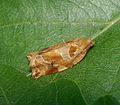Archips xylosteana
| Archips xylosteana | |
|---|---|

| |
| Scientific classification | |
| Kingdom: | |
| Phylum: | |
| Class: | |
| Order: | |
| Family: | |
| Genus: | |
| Species: | A. xylosteana
|
| Binomial name | |
| Archips xylosteana | |
| Synonyms | |
| |
Archips xylosteana, the variegated golden tortrix or brown oak tortrix, is a moth of the family Tortricidae.
Description
Archips xylosteana is a medium-sized to large moth with a wingspan reaching 15–23 millimetres (0.59–0.91 in). The females are usually slightly larger than the males. The basic color of the fore wings varies from yellow-brown or ocher to reddish brown, mottled with pale brown markings. Forewings are broad and roughly rectangular. Hind wings are light grayish brown. The design of the wings may appear lightly asymmetric, because at rest one of the wing covers the other and hides part of it. The moths rest during the day in the foliage of trees and shrubs. Their activity begins at dusk. They fly from June to August in one generation. They overwinter on tree trunks and thick boughs.
The caterpillar is varies from whitish gray to bluish with greenish reflections and have a black head. It grows protected in a rolled leaf, perpendicularly to the midrib, from April to June. These larvae are polyphagous, feeding on various shrubs and deciduous trees, mainly oak (Quercus), elm (Ulmus), Linden (Tilia), hazel (Corylus), maples (Acer) and ash (Fraxinus). The can also be found on various fruit trees (apple, pear, etc.) and on some herbaceous plants.
-
Moth
-
Moth
-
Moth, female
-
Caterpillar
Distribution
This Palearctic moth is widespread in most of Europe and Asia and north to Japan.
Habitat
This moth species prefers hilly and mountainous areas.
References
External links




